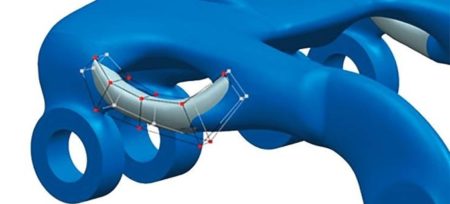Siemens Digital Industries Software, the division of German industrial giant Siemens, announced in December the next version of its Parasolid geometry kernel software technologies (modeling engine) used extensively throughout the engineering software world.
The new release expands on what the company says is the “exciting potential of Convergent Modeling” for applications such as generative design, generative engineering, 3D printing, and reverse engineering with new tools for integrating previously incompatible facet and B-rep data formats.
Parasolid v.33
Parasolid now allows the intersection of meshes with all classic B-rep surface types. It can also perform more complex configurations of fillets and chamfers on mixed models.

Parasolid now includes enhanced support for mixed models to help drive significant productivity gains.
Also, and with a bit more applicability to the AEC world, there are also new tools for the direct editing of faces and for rendering and repairing models. Extensive classic B-rep enhancements have also been made in areas such as blending, sweeping, non-uniform scaling, and rendering, bringing users gains in modeling flexibility and performance.
A number of classic modeling enhancements have been announced. Including:
- improved creation of neutral sheets from pairs of faces with varying offsets
- improved solid sweep quality when defining lathing operations, by specifying sections of the path to spin around a supplied turn axis
- general transformations, including non-uniform scaling, can now be applied to all body types including general bodies
- region control in general booleans allows fine control over which topologies are retained, target or tool, when solid regions overlap
- classic sheets can now be extended to a target that contains facet geometry
- returning the minimum distance between transformed input entities without directly applying transformations to the entities
Additionally, classic operations are extended to operate with mixed geometry, including:
- replace any combination of classic, facet, or mixed faces with a classic, facet or mixed sheet
- replace the surfaces of faces with surfaces containing mixed facet and classic geometry
- transform, replace and patch collections of mixed faces in face change operations
- project collections of curves of mixed geometry categories along a supplied vector
- project onto bodies and faces with mixed facet and classic geometry
- supply face-face and face-edge matches in Boolean operations involving or resulting in mixed models
And more complex blending operations and configurations are possible now in mixed models:
- notch blend with constant radius
- a mixture of classic and mesh faces may be used when blending three edges at a vertex
- smooth overflows between classic and mesh faces are now supported
- chains of mixed classic edges and facet edges are supported for apex range chamfers
- deleting chains of blends with blend surfaces of mixed geometry and/or unders of mixed geometry
There are also new capabilities with faceting and rendering, repairing mixed models, and native lattice support in Parasolid.
The Parasolid geometric modeling kernel is used in Siemens’ own Solid Edge® software and NX™ software and is at the core of the Xcelerator™ portfolio’s open and flexible ecosystem. Parasolid is also used in over 350 other applications from industry-leading CAD/CAM/CAE/AEC software vendors.
Learn more about the latest release of Parasolid here.



Reader Comments
Comments for this story are closed